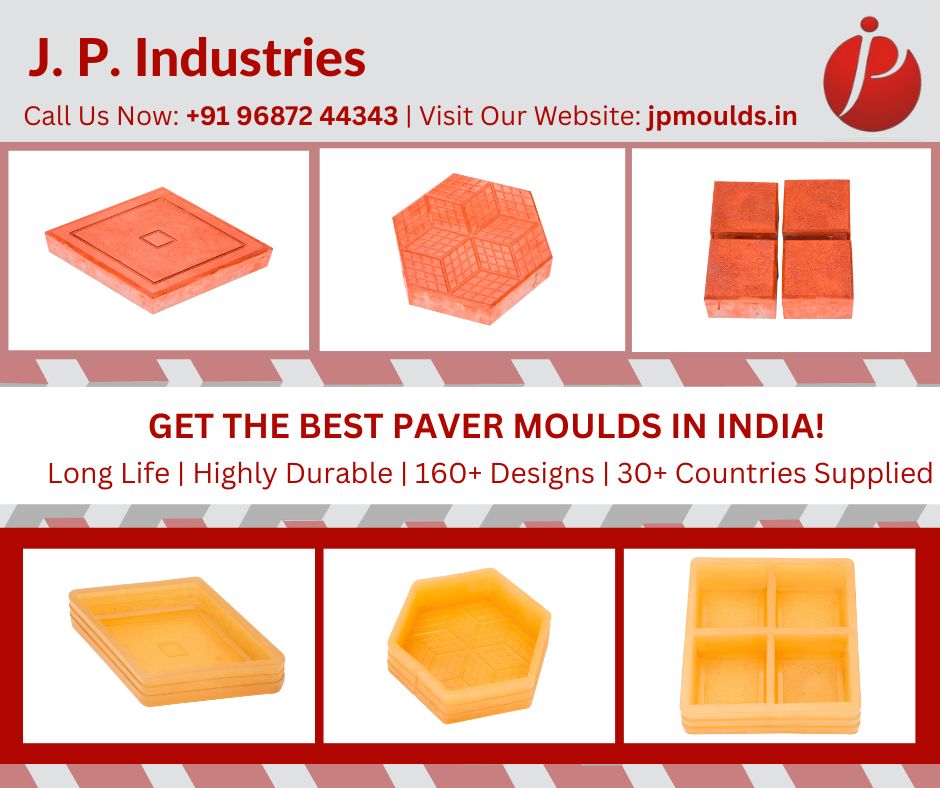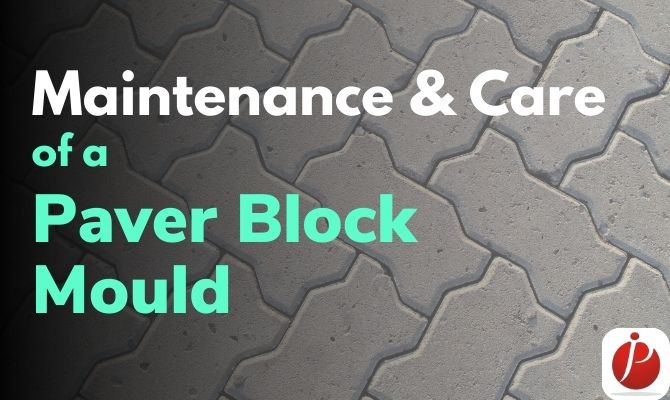- Get The Best Quality Molds From Us
- +91 9687244343
- +91 9687245001
- support@jpmoulds.in

Concrete Tiles: The Future of Flooring
July 27, 2023Maintenance & Care of a PVC Paver Block Mould
Want to preserve your paver block moulds? This article will discuss how to maintain a paver block mould for the best usage and longevity.
But, let us first understand why it is important to maintain a paver block mould.
Why is it Important To Maintain a PVC Paver Block Mould?
Paver block moulds made from PVC are made for longevity. They are made durable and flexible for easier usage. Moreover, they also provide the best quality. However, over time they tend to deteriorate as it is the nature of the product.
If the paver block mould is not maintained properly & taken care of, it might even deteriorate more quickly than it should.

On the other hand, if the PVC paver block mould is maintained properly, they tend to produce high-quality paver blocks for more than 5 years.
Maintaining PVC paver moulds has various benefits for paver block manufacturers.
Let us understand these benefits in detail.
Benefits of Maintaining a PVC Paver Block Mould
There are many benefits of maintaining a PVC paver block mould.
Quality of the Paver Block
A paver block manufacturer needs to produce a great quality paver block. Why? Because they get better profit margins. People are willing to pay higher prices for a better quality product. Hence, it becomes most important to maintain your paver block mould.
If the quality of the PVC paver mould is one factor that determines the quality of the paver block, then the maintenance of the paver block mould is the second. The better you maintain your PVC paver block mould, the better the quality of the paver block you get.
Reduced Costs
When you are using PVC paver moulds, you are already signed up for longevity. But when you maintain them, you unlock the feature of cost-effectiveness. The upfront cost of a PVC paver mould is more than the plastic variants.
However, due to its durability, that cost is easily recovered within the first 2 years of its usage. Anything after 2 years of usage is profit from the moulds.
But when you maintain the PVC paver moulds, you can use it for a longer period than expected. Hence, the longer you use it, the more the profits.
Since you have already recovered your paver mould costs, after maintaining your paver mould, the cost of a paver block mould is ZERO.
Efficient Production
For producing the best quality paver blocks, you must have a good & uninterrupted flow. When the PVC paver block moulds are not maintained, they interrupt the flow. How?
Whenever you do not maintain the PVC paver moulds, many problems interrupt production. Problems such as:
- Cement gets stuck in the paver moulds
- Difficulty in de-moulding
- Colour gets stuck in the paver moulds
- Cracks in paver moulds
- Increase in hardness of the moulds
- Increase in bends in the paver mould
- Deformity in the shape of the moulds
All such problems occur in the PVC paver block mould. But, none of it would occur if the moulds are maintained.
The possibility of manufacturing delays or disruptions due to malfunctions or inferior paver blocks is decreased when moulds are regularly maintained.
Effective moulds enable producers to make paver blocks at a steady rate, better meeting demand and deadlines.
Safety
Whenever making a paver block, one must focus the most on the safety of using the paver block. A paver block needs to be levelled perfectly so that you get stable pavement to walk on.
When you have well-maintained PVC paver block mould, you get a nice and even pavement surface. Such paver moulds ensure that the paver blocks are produced with accurate dimensions & structural integrity.
The safety of walkways, driveways, and other paved places is increased by evenly shaped stones that decrease tripping hazards.
No Contamination & Impurities
A lot of raw materials can get stuck inside the paver block mould. As stated above, cement, concrete, & colour can get stuck inside the paver mould. Hence when producing a paver block, such debris can contaminate the paver block.
This contamination can reduce the strength of the paver block. Moreover, it can also deteriorate the finish of the product.
Sustainability & Environmental Impact
Maintenance of the paver moulds directly increases the lifespan of the paver moulds. This, in turn, reduces the need for new paver moulds. As a result, the consumption of raw materials and energy is reduced.
Hence, the production of the paver blocks becomes more environmentally friendly & more sustainable.
How to maintain a PVC Paver Block Mould?
Maintaining a PVC paver block mould is not a difficult task. There are some rules to follow and you will then be able to create high-quality paver blocks.
1. Scraping post filling
Most of the moulds get problems because there is concrete stuck on the walls and outside of the paver mould. When you fill the mould, it is highly recommended that you scrap the excess concrete stuck on the mould with a metal scraper.
2. No Acid Washing
Many manufacturers wash the PVC paver block moulds with acid. This is one of the biggest mistakes that deteriorate the quality of the paver mould. Acid degrades the surface finish of the paver mould and makes it brittle with its usage.
So, what should be done?
Concrete once poured into the mould, needs to be dried out completely. When it is dried out thoroughly, it will pull out all the residue of concrete with it. There will be no debris stuck inside the mould.
3. Cleaning staging sheets before loading filled moulds on
When you pour the paver moulds with concrete, they are then placed on the plastic sheets for stacking. If the plastic sheet is not clean, then there is a high chance that the plastic sheet surface is uneven.
When you place your paver moulds on an uneven surface for drying, it causes the paver block articles to lose their original shape and get some deformities.
In order to prevent that from happening, all you need to do is scrap off the debris from the plastic sheet and wipe it off with a wet cloth.
4. Keeping moulds for 48hrs before changing colours
Whenever you are demolding your paver block within 24 hours, there is some colour stuck in a minimal amount inside the mould. This colour doesn’t do any damage. However, if you pour different colours inside the mould, then the stuck colour may get mixed with the new colour. Thus, wasting an article.
In order to clean the colour, all you need to do is let the paver block dry for 48 hours. The concrete will pull the residual colour with it and clean the PVC paver block mould itself.
5. Letting the article fix fully for 24hrs
One of the biggest problems is that the paver block is pre-maturely de-moulded. When the paver block is not dried properly, then there are all kinds of issues in the paver block as well as the paver block mould.
Concrete has the property of binding with the materials around it. When the concrete is drying, it is constantly binding the materials together. It gets fully intact when completely dried out.
Hence, when the paver block is not dried out, then the article has not bonded with the concrete. As a result, there is residual debris in the paver mould.
To prevent this problem, all you need to do is let is dry for at least 24 hours. Even if there is debris in the mould, the next properly dried paver block will pull all the debris and colour. Moreover, it will clean the mould for better quality.
6. Store Properly
When not in use, store the PVC mould in a clean and dry area away from direct sunlight and extreme temperatures. Avoid stacking heavy objects on top of the mould, as this can cause deformation.
7. Avoid Overloading
Do not exceed the recommended load capacity of the mould. Overloading the mould can lead to deformation or premature wear, reducing its lifespan.
8. Avoid Impact
Handle the mould with care and avoid dropping or subjecting it to heavy impact, as PVC can become brittle over time.
9. Follow the Manufacturer’s Guidelines
Always follow the manufacturer’s guidelines and recommendations for maintenance and usage. They may provide specific instructions tailored to the PVC paver block mould you are using.
10. Monitor Concrete Mix
Use high-quality concrete mix with appropriate additives and aggregates. Poor-quality concrete or improper mix proportions can lead to more wear and tear on the mould.
Final Words
In conclusion, it is important to maintain and clean your paver mould thoroughly. It will gift you with many benefits and advantages. Most importantly, a paver block mould should not have concrete stuck on the walls.
It causes all the major problems that can cost you heavily. Just by taking care of the concrete and paver moulds, all your problems go away.

